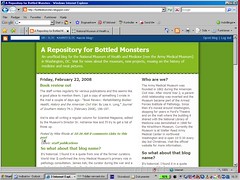In an earlier post I wondered about the current fashion of ’things-that-talk’-talk that has invaded some valleys of cultural studies. For example, at a forthcoming workshop in Vienna, the organisers invite the participants “mit den Dinge zu argumentieren und diskutieren” (to argue and discuss with the objects), and they hope that “die Dinge gleichsam selbst zu Wort kommen” (the things in themselves shall have their say).
This is not an isolated event. The theme of the next meeting of the German Ethnographical Society (Gesellschaft für Ethnografie), to be held in Berlin 21-22 November 2008, is “Die Sprache der Dinge — kulturwissenschaftliche Perspektiven auf die materielle Kultur” (The language of things — cultural scientific perspectives on the material culture). The organisers not only wish to highlight the language of things, they emphasise “die Wirkmächtigkeit der Dinge” (the action potential of things) and “ihre Kulturgenerierende Funktion” (their culture generating function):
Dinge … als Handlungsträger und Akteure … Vermittler und Übersetzer … Produzenten von Bedeutungen, von sozialen Beziehungen und Praktiken, von Identitäten, Wertvorstellungen und Erinnerungen (things as carriers of action and actors … mediators and translators … producers of meaning, of social relations and practices, of identities, values and memories).
Accordingly, the propsed themes for the meeting include “Dinge als kontextspezifische Akteure in der Praxis” (things as context specific actors in practice) and “Dinge als Produzenten von Praxen, Bedeutungen und Identitäten” (things as producers of practices, meanings and identities). (All quotes are from Wednesday’s H-SOZ-U-KULT@H-NET.MSU.EDU; see also the conference website).
In other words, the German etnographers not only want to restate the importance of material objects (things) for the understanding of culture and society. They also suggest that things are speakers, actors, mediators, translators, and producers of all possible social and cultural meanings and relations, and so forth.
The new focus on things in cultural studies is exciting. But I cannot see why some scholars take the further step to endow things with the status of actors/mediators/translators/producers etc. I mean, after all, if you ask an ethnographer if he/she really believes that a milk container literally has a language, or that it acts (really acts), or translates, and so forth, then I guess few would suggest it really does. And yet, the conscious actor category somehow creeps into the scholarly terminology. Why?
I’ve just discussed the matter with my learned friend Michael, who suggests that it may be an expression of a latter-day fetishism, that is, a revival of the ‘primitive’ religious practice to attribute powers to inanimate objects, like stones or pieces of wood (“the veneration of objects believed to have magical or supernatural potency”; Britannica).
Sounds plausible at first. All kinds of fundamental religious thinking (and its backlash counterpart, devout atheism) is washing over us like a tsunami. But then again—fetishism is not one of these. There must be a better explanation for this wave of ‘things-that-talk’-talk.





